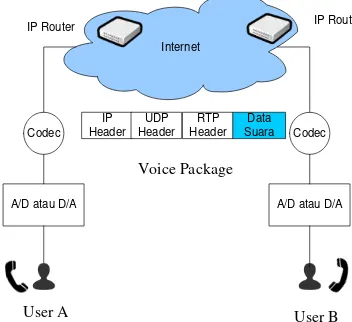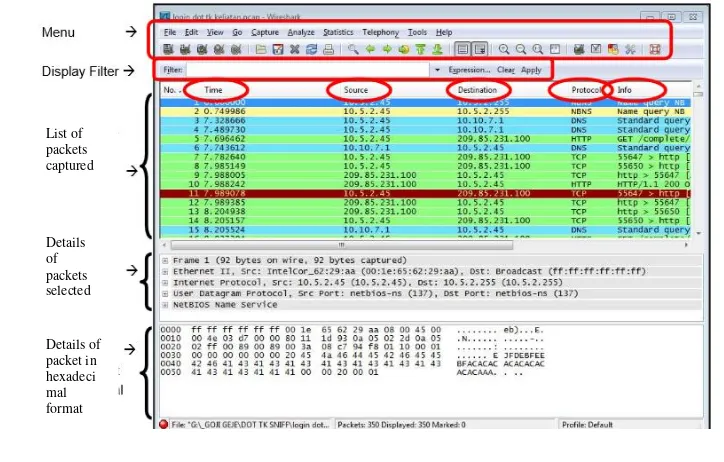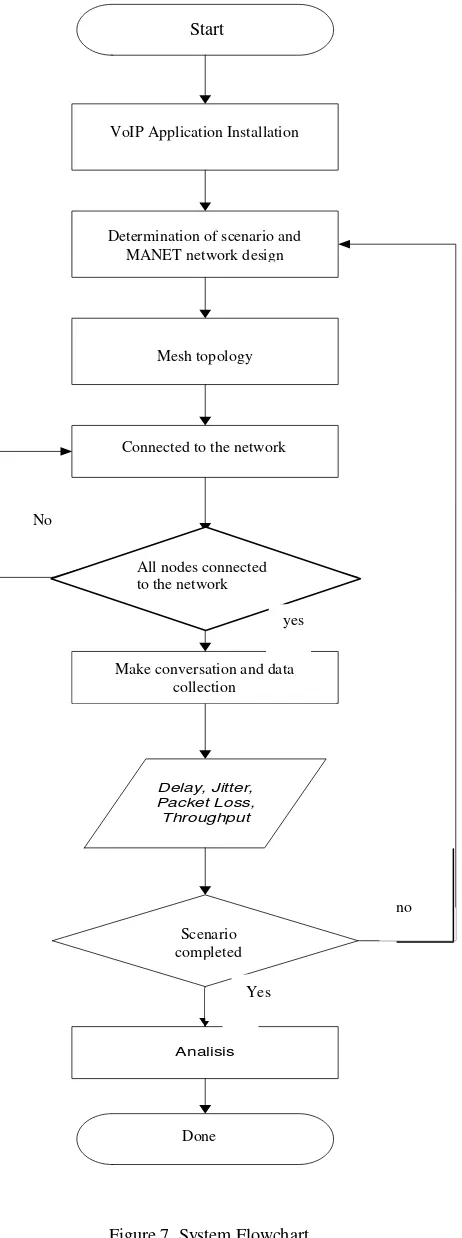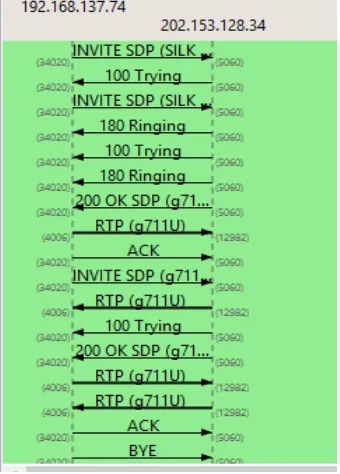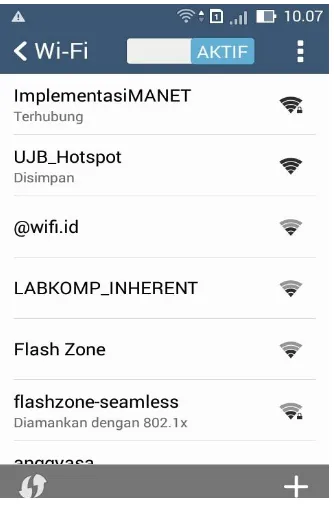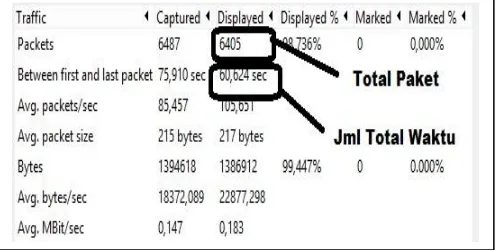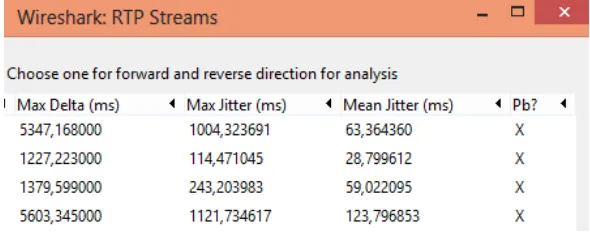Buletin Pos dan Telekomunikasi Vol. 13 No.1 (2015) 79-96
79
DOI: 10.17933/bpostel.2015.130106
Performance Analysis of VoIP Call Application Android in MANET
(
Mobile Ad Hoc Network
)
Analisis Unjuk Kerja Aplikasi VoIP Call Android di Jaringan MANET
(Mobile Ad Hoc Network)
Ryan Ari Setyawan
Jurusan Teknik Informatika, Fakultas Teknik, Universitas Janabadra Jl. Tentara Rakyat Mataram No. 55-57 Yogyakarta 55231, Indonesia
e-mail: [email protected]
Penelitian ini bertujuan menganalisis kinerja aplikasi VoIP call android di jaringan MANET (mobile ad hoc network). Hasil pengujian menunjukan bahwa aplikasi VoIP call android dapat digunakan di jaringan MANET. Delay yang dihasilkan paling besar di pengujian indoor dengan jarak 11-15 meter yakni sebesar 0,014624811 seconds. Packet loss yang dihasilkan pada range 1%-2%, sedangkan standar packet loss yang ditetapkan oleh CISCO untuk layanan aplikasi VoIP adalah < 5%. Jitter yang dihasilkan yakni antara 0,01-0,06 seconds sedangkan standar yang ditetapkan oleh CISCO adalah ≤ 30 ms atau 0,03 seconds. Throughput yang dihasilkan pada proses pengujian yakni antar 161 kbps-481 kbps. A B S T R A CT
Keywords: Android VoIP MANET
This study aims to analyze the performance of VOIP call android application in the MANET (mobile ad hoc network). The results showed that VoIP applications could be implemented in MANET network. The highest delay is produced in indoor testing with distance of 11-15 meters, which is equal to 0.014624811 seconds. Packet loss is generated in the range of 1% -2%, while packet loss standards set by Cisco for VoIP application services are <5%. The jitter is between 0.01 to 0.06
seconds, while the standard set by CISCO is ≤ 30 ms or 0.03 seconds. Throughput
generated in the testing process is between 161 kbps-481 kbps.
1. Introduction
Smartphone technology is now growing rapidly, enabling users to communicate, either in real-time or not. Along with the foregoing, smartphone application features that allows users to communicate began to emerge from Mobile Yahoo Messenger, Kakao Talk, We Chat, Line, Bee Talk and others. Features of these applications is very easy. Only with the Internet network connection, device users can communicate conversation without boundaries, and at a low cost. Indeed, the concept of the application features is utilizing a network technology of Voice over Internet Protocol (VoIP) as an internet multimedia system (IMS) access. But it can not be separated from connectivity used. Wireless connectivity is one of the connectivity features for communication on smartphones. It shows that the compressoin of wireless adapter has currently been estalished in the device. The existence of such wireless adapter compression can be pushed to develop small sphere to build communication networks such as Mobile Ad Hoc Network (MANET). MANET is a wireless network consisting of a collection of mobile station which is dynamic and spontaneous, can be applied anywhere without using the existing infrastructure network. In the ad hoc network each node not only serves as the sender and receiver of information but also serves as a network support such as routers.
MANET characteristics which have a dynamic topology can freely move anywhere and anytime result in network topology that can change randomly and rapidly at unpredictable times. Bandwidth limitations and capacity of each band is different. Mobile nodes use batteries as a source of power. Limited battery power requires each operation to be run efficiently.
Based on the description above, devices such as smartphones and laptops can be used as nodes that can communicate with one another to form a MANET over the wireless network. But it raises the question as the problems statement that can be raised as to how the influence of the communication that occurs in the application of VoIP internet phone call in MANET.
Nodes used in this study uses two smartphones with Android operating system and a laptop unit. While the application of VoIP calls used is CssipSimple which will be analyzed using wireshark software to retrieve data that occurs at the time of the communication. The method used in this research is to measure the Quality of Service produced namely the throughput, delay, jitter and packet loss. The purpose of using QoS method is to determine the effect of communication that occurs on the VoIP call in a mobile ad hoc network and QoS can be used as a measure for determining the performance of an internet network.
2. Desktop Study
Various studies on the VoIP network in MANET that has been done as the design and implementation of ad hoc VoIP by implanting p-SIP (Session Initiation Protocol) server (Chang, Sung, Chiu, & Lin, 2010). The research aims to design a p-sip server embedded on an ad hoc VoIP network. The method used to measure the performance of VoIP is QoS method, but because the emphasis is p-SIP server, the measurement of performance focuses heavily on REGISTER host and INVITE in SIP.
Subsequent studies namely on VoIP packet delay in a single hop in ad hoc IEEE 802.11 networks (Barcel, Bellalta, Cano, & Sfairopoulou, 2008). The study introduces the predictions for VoIP model on the IEEE 802.11 for ad hoc networks. The model was used to find out the impact or delay prediction occurred on VoIP via configuration parameters such as codecs, packetization interval, and data rate.
Studies on VoIP communications in an ad hoc wireless network through a gateway was conducted by Faloso et.al (Fasolo et al., 2007). The study introduces a formula to estimate the number of sustained voice sessions in a single hop cell. The accuracy of these formulas can be implemented through NS2 network simulation software.
Further study is on the analysis of VoIP over VANET network (vehicular ad hoc networks). The method used to carry out analysis of VoIP on VANET network is using Mean Opnion Score (MOS) methode that is to measure the quality of voice communication over VANET network (El Brak, Bouhorma, & Boudhir, 2012).
Several studies on the VoIP network in MANET has been described above, in this research the author wanted to do research on the communication that occurs in android VoIP call app in Mobile Ad hoc Networks. Considering the application features in android has already had VoIP Call feature. Only by connecting internet, the users can use the Internet phone service. The method used in this research is the methode in measuring the quality of voice services. QoS parameters such as delay, jitter, throughput, and packet loss can be used as a measure to determine the quality of voice produced when the communication is performed. QoS measurements shall be performed later on when communication takes place through wireshark software, the voice data collected to then be analyzed and quantified by the parameter of delay, jitter, throughput and packet loss.
2.1.Voice over Internet Protocol
81 frequency (bandwidth) with compressed system which level is greater than the cell compression. In the Global System for Mobile Communication (GSM), normal voice is encoded in 64 kilobit can be reduced to 13.3 kilobits per second with better sound quality. But in VoIP voice compression is performed on 13.3 kilobit channel into 8 kilobits and will be smaller (Setyawan, Sulistyo, Hantono, Graphic, and Yogyakarta, 2014). The basic scheme of VoIP performance can be seen in Figure 1.
Codec Codec
Figure 1. VoIP Performance Scheme (Setyawan et al., 2014)
Figure 1 illustrates that the user A and user B can communicate through the Internet phone service, where the voice data will be processed through the analog to digital converter or vice versa and broken down in the form of packets of voice data that is sent to the addressee namely user B. Compression is done in STDI (Digital Telephone Central Indonesia), so that a 64 kilobit channel capacity can be used by a 4-5 voice. With VoIP technology compression is done in such a way that each channel is no longer 13.3 kilobit but 8 kilobits.
2.2. Session Intiation Protocol
One of the protocols used in this research is session initiation protocol (SIP). SIP Protokol is a multimedia standard protocol, a product of the Internet Engineering Task Force (IETF) and has been used as a standard of VoIP usage. SIP is a protocol placed at the application layer to define the initial process, alteration, and termination of a multimedia communication session. SIP can also be said to have the characteristics of client-server, meaning that the request made by the client and addressed to the server. The server processes the request and provide a response to the request made by the client. Request and response to the request is called SIP transaction.
Figure 2. SIP Performance Scheme (Setiawan et al., 2014)
User [email protected] User [email protected]
-> making calls -> receiving the call
Voice Package
Figure 2. Explains that SIP works when [email protected] enter the username and password
that have been obtained from the SIP
serveror proxy SIP and authenticated. [email protected]
can make calls to [email protected], then the communication occurs in Real-time transport
protocol (RTP). Figure 2 also shows that SIP is a signaling protocol at the application layer that
serves to build, modify, and terminate a multimedia session involving one or several users.
Multimedia session is the exchange of data between users that include voice, video or text.
SIP does not provide services directly, but provides a foundation that can be used by protocols
of other applications to provide a more complete service to users, for example by RTP (Real Time
Transport Protocol) to
transferdata in real-time and SDP (session description protocol) to describe
multimedia sessions (Fahdi, Patih, Fitriawan, & Yuniati, 2012). Development of a multimedia
communication with SIP is done in several stages:
User location, determine the location of users who will communicate.
User availability, determine the level of inclination of the callee to engage in communication.
User capability, determine the media and media-related parameters that will be used for communication.
Session setup, 'ringing' establishment of relations between the callers and the callee.
Session management, includes the transfer, modification and termination of sessions.
2.3. Real Time Transport Protocol (RTP)
Real time transport protocol (RTP) is a protocol that defines a standard transmission data format of voice and image. RTP was first developed by audio video transport working group IETF and first published in 1996 as RFC 1889. RTP does not have standard TCP and UDP ports. Although it does not have any
standardized
definition, RTP is configured using range port 16384-32,767.At first RTP protocol is designed for multicast, but is now widely used in applications that are unicast. RTP is used for media streaming systems such as video conferencing and push-to-talk system. In VoIP
RTP does
not
provide a mechanism for determining the length of a data transmission. Besides RTP does not guarantee Quality of Service (QoS) of a data transmission. Treatment of reliability is done by the mechanism on a higher layers in the OSI model.2.4.Mobile Ad Hoc Network (MANET)
Mobile Ad Hoc Networks is a wireless network consisting of a collection of mobile nodes that are dynamic and spontaneous, can be applied anywhere without using the existing infrastructure network (cellular or PSTN). Examples of mobile nodes are notebooks, PDAs and smartphones. Nodes are free enter and leave the network, the nodes are also free to move or in stationary position. Each mobile node has a wireless network interface and communicate using transmission medium. Because the transmission medium has a limited transmit power, then communication between nodes is performed by passing one of several nodes (nodes serve as routers and hosts) therefore MANET is also called multihop network. Here are some characteristics of the advantages and drawbacks of MANET:
83
Dynamic topology of nodes in MANET are free to move anywhere and anytime. This resulted in a network topology to change randomly and rapidly at unpredictable times.
Mobile nodes are always on the move (mobility) can access information in real time when dealing with other mobile nodes, so that the exchange of data and decision-making can be immediately implemented.
Flexible for a particular purpose as this network is indeed temporary.
Can be reconfigured in a variety of topologies, from a small number of users to many users according to the applications and installations (scalability).
Disconnection is frequent, because it is not always located within the coverage area.
Limited communication bandwidht.
Short battery life.
The capacity of the mobile node is limited and varied.
2.5.Mesh MANET Topology
Mesh MANET topology is one kind of network where every node in the network are not only receive or send data of its own, but also serves as a relay for other nodes. In other words, each node work together to build and transmit data on the network. The benefits include:
Can build a reliable network.
Installation costs are very low.
Adaptive to changing conditions/network topology.
Suitable for military purposes, the Rural/Village area and mountains.
A mesh network can be designed using the flooding technique or routing technique. If using the routing technique, the message will be sent through a path, by "jumping" from one node to another node until the destination is reached. To guarantee the existence of the route/path, then a routing mechanism should allow continuous connection and configure automatically if there is a broken or blocked paths, using the "self-healing" or "self-improvement" algorithm. A mesh network occur where all nodes are connected to each other as a mutually connected network.
Mesh network can be seen as a kind of ad-hoc network. Mobile ad hoc network (MANET)
and mesh network are very close with one another, but MANET should be able to resolve
problems that occur because of node mobility.
Self-healing capability enables a network-based routing to keep working if one node is
performance. In general, there are several important parameters that affect Quality of Service (QoS) voice services in the VoIP network. This parameter is used as a description of the level of performance of a VoIP network. The QoS parameters are delay, jitter, packet loss and throughput.a. Delay
quality for users is 250 ms. Delay end-to-end is the amount of delay of analog to digital sound conversion, delay packetization can also be referred to as packets long delay and delay of network in specific t (time). Various source types could cause delay. The types are shown in Table 1.
Table 1. Types of Source of Delay
Delay Description
Processing delay This delay occurs during the process of coding, compression, decompression, and
decoding.This delay depends on the standard codec used.
Packetization delay Delay caused by the accumulatoin of bit voice sample to the frame. For example, G.711
standards for payload of 160 bytes takes 20ms
Serialization delay Delay is due to the time required for the transmission of IP packets on the originating side
(sender).
Propagation delay This delay occurs due to propagation or travel. IP packets on the transmission medium to
the destination address. For example the propagation delay in the Table will take 4 to 6 μs
per kilometer.
Queueing delay Delay is caused by packet waiting time for the queue to be served.
Component delay Delay is caused by a number of components used in transmission system.
Source: (Setiawan, 2012a)
As for the level of quality of the network is based on the delay is shown in Table 2.
Table 2. Delay Quality Level Category
Delay Category
0-150 ms Acceptable for most user applications
150-300 Still acceptable if implementers have learned as a result of the transmission time of user
application QoS
More than 300 ms Unacceptable for planning the design of the network in general.
Source: (Setiawan, 2012a)
To calculate the delay that occurs Equation 2 is used (Setiawan, 2012b) (Suryawan, Husni,
& Anggraini, 2012).
P
Twf
Delay
(1)Where :
Twf = Time Between first and last packet
P = Amount of Packet
b. Throughput
Throughput is an effective data transfer rate, which is measured in bps. Header in the data packet
reduces this value. Throughput can be calculated by looking at the number of incoming packets to send.
Throughput is also the actual ability of a network to perform data transmission. Usually, throughput is
always associated with bandwidth. Because throughput can indeed be called the bandwidth in the actual
85 going on. Throughput is also interpreted as the number of bits per second received successfully through a
system or communications media in particular observation time interval. Generally throughput is
represented in units of bits per second (bps). To capture the value of throughput, it can be done by looking
at the value of bits per second (bps). To calculate throughput occurred, we can use Equation 2 (Setiawan,
2012) (Suryawan et al., 2012).
Throughput = Number of Data (2)
Transmission Time
Where :
Average Byte/sec = number of data
Time between first & last packet (sec) = time
c. Packet Loss
Packet loss is the number of lost packets in a packet network which is caused by the collision, the full
capacity of the network, and packet drop caused by packet time to live expiration. The equation for
calculating the packet loss can be shown in Equation 3.
Packet Loss = (3)
d. Jitter
Jitter is a variation of delay. Jitter is caused by the variation in packet arrival time. Variations arrival of
these packets can be caused by long queues of data, the length of time of data processing and the length of
time required to collect packets of data at the end of the transmission process to become an integral frame.
2.7.Wireshark
Wireshark is one of a network monitoring software that is typically used by network administrators to
capture and analyze network performance. One of the reasons why Wireshark has been chosen by an
administrator is because its interface uses a Graphical User Unit (GUI) or the graphical display.
Figure 5. Wireshark
Details of packets selected
Description :
1. Menu: Inter-menu navigation of the available menus in wireshark
2. Display filter: Column to write syntax to filter (restrict) what packets are going to be displayed on the
packet list.
3. List of packet: Display of packets captured by wirehsark, in an orderly manner from the first packet
captured and so on.
4. Details of packet: a packet that would bring certain information between the different packets.
5. Hexa Details: The selected package detail displayed in hex form will sometimes be easier to get the
information.
3. Methods
In this research, the measurement of voice quality is carried out using QoS method. The voice data is
used by 1.830 seconds. Network used to connect between the nodes (devices) with other nodes used
wireless LAN network. When there is communication between one node with another node, the data
communication that occurs in the network is captured using wireshark software. Then the captured network
data by wireshark software is analyzed through parameter approach namely delay, jitter, throughput and
packet loss. The approach was conducted to determine the quality of voice produced by a VoIP network in
MANET.
3.1. System Analysis
System an alysis is the decomposition of a whole system into its component parts, in order to get the
software and hardware that is required in this study. The analysis is done so the process of this research can
proceed as planned.
This reserach required hardware and software as follows:
a. Hardware Analysis
Hardware is the main system of a physical system, which consists of interlinked components. The
hardware can also be regarded as a device. The device will be used later in this study as a node. The
Device are:
1) One unit of the laptop as one of the nodes to implement MANET with the followinh specifications:
a) Network : WiFi 802.11b/g/n, Ethernet Port
b) Support WiFi adaptor/ad hoc WiFi
c) 5 hours battery (4-cell battery).
2) Two smartphone with minimum specifications of:
a) Operating system: Android 4.3 (Jelly Bean)
b) Network: HSDPA 42.2 Mbps; HSUPA 5.76 Mbps
c) Connectivity: WiFi 802.11/b/g/n
d) Support WiFi Direct, hotspot WiFi/ad hoc WiFi
e) Battery: 1170 mAh LiPo
87 The software needed in this research to test the VoIP application in MANET network as follows:
1) CsipSimple, a mobile softphone application or internet phone applications (VoIP), which uses
session initiation protocol (SIP) for android devices. CsipSimple can be obtained easily on google
play android.
2) Wireshark, software to capture data packets over the internet.
3) Voiprakyat.or.id, free SIP server to get a SIP account such as SIP username and password.
3.2. System Modeling
The system modeling is an overall picture of the performance of the system or the flow path of the
system. System modeling in this research can be seen in Figure 7. Figure 7 shows that the first thing to do is
to install the VoIP call application in the CsipSimple android smartphone application. Then perform the
determination of test scenarios and the design of MANET network to determine the nodes that will be used.
Furthermore, the nodes used are into mesh topology. Then one by one node is connected to each network. If
you are connected, make conversation and the data is captured using wireshark software. And analyzed in
accordance with the parameters of delay, jitter, throughput and packet loss.
3.3.System Design
System design in this research is using mesh topology in MANET network. Mesh topology in this
research are shown in Figure 8, which shows that smartphone A, B and laptop smartphones serve as nodes.
At the nodes, there are the dotted lines between a node and other nodes. The dotted lines show that
communication occurred is able to move freely between one node and another.
3.4.Implementation
The implementation process in this research is divided in several implementations namely application
implementation, SIP protocol implementation and implementation of the MANET network.
a. Applications implementation
VoIP Call applications implementation is using CsipSimple application, which had previously been
Mulai
Instalasi Aplikasi VoIP
Penentuan skenario dan Perancangan jaringan MANET
Implementasi topologi Mesh
Terhubung ke jaringan
Semua node terhubung ke jaringan
Lakukan percakapan dan pengambilan data
Delay, Jitter, Packet Loss, Throughput
Skenario Selesai
Analisis
Selesai
Ya Tidak
Ya
Tidak
Figure 7. System Flowchart Start
VoIP Application Installation
Determination of scenario and MANET network design
Mesh topology
implementation
Connected to the network
No
All nodes connected to the network
Make conversation and data collection
yes
Scenario completed
no
Yes
89
Smartphone A Keterangan
Smartphone B
Laptop
Figure 8. Mesh Topology
Figure 9 is a drawing of CsipSimple application which is one of the VoIP Call application available on google play android. Then to use these applications users are required to insert username and password that have been obtained from the SIP server is shown in Figure 10. The picture shows the SIP account settings users that are required to enter the account name, user, server name and password. If the SIP account has been entered, server will authenticate, as shown in Figure 11, which shows the SIP account has been registered which means that SIP account entered into the setting is authenticated and ready for use.
Figure 9. CsipSimple Application Figure 10. SIP Account Setting Figure 11. SIP Account Authentification
b. Implementation of SIP Protocol
Once the CsipSimple application has been installed, the next process is the implementation of the SIP protocol which is the implementation process of the use of the SIP protocol in the application. SIP protocol will then make signaling process so that the CsipSimple application can communicate each other.
Table 3. SIP Account
Configuration Smartphone A SIP Account Smartphone B SIP Account
Account name 147400 148543
Password GYJAEP 226DXC
Server voiprakyat.or.id voiprakyat.or.id
Port 5060 5060
In Table 3 SIP Account A and SIP Account B are used to perform the configuration in the application. After entering the SIP account, it can be authenticated by the SIP server. Authentication process of smartphone A SIP account is shown in Figure 12. The figure shows that the smartphone A SIP account with the account name [email protected] with IP: 192.168.137.74 which has been authenticated (invite) in voiprakyat.or.id server with IP: 202.153.128.34. To authenticate other SIP accounts, it has the same authentication.
Figure 12. SIP Protocol Authentication.
c. MANET Implementation
Once the application and SIP account is ready to use the next process is the implementation of MANET network. This process perform ad hoc wifi so that all nodes can be connected to each other.
The implementation is as follows:
1. Creating an ad hoc WiFi in laptops which later serves as coordinator node via command prompt admin (Windows 8). The process is shown in Figure 13. Figure 13 shows the process for creating an ad hoc WiFi (Windows 8) with command prompt admin by writing the following command:
91 Figure 13. Ad Hoc WiFi
2. Then, if succeeded, enable ad hoc wifi type the following command: C:\windows\system32>netsh wlan start hostednetwork
3. Ad hoc wifi can automatically be used by other nodes as shown in Figure 14.
Figure 14. Implementation of Ad Hoc WiFi
4. Next, connect all the nodes of smartphone A and smartphone B to the ad hoc WiFi. Figure 15 shows that each smartphone as a node is connected to ad hoc networks.
4. Results and Discussion
After all nodes have been connected, the next process is to conduct testing. The testing process in this research is done by testing indoors and outdoors. The tests are conducted to test the characteristics of MANET networks that have limited transmission power.
But before doing the test, there are several test scenarios to be done. The goal is to collect a fair testing data. The test scenarios are:
a. Ensure that all nodes have been connected to the ad hoc network.
b. Enter your username and password according to the SIP account obtained from the SIP server voiprakyat.or.id
c. After that wait SIP account each for smartphone to be authenticated by the SIP server until ready for use.
d. One of the smartphone inserts Caller ID or destination phone number. e. Send voice data with a duration of 1,830 seconds and the nodes move freely. f. Capture the data with wireshark software to calculate the test results.
In addition to the testing scenario, it has been described that the parameters for measuring the quality of the network is generated using the parameters of delay, jitter, packet loss and throughput. The testing process is also done indoor and outdoor with inter-node distance of 0-5 meters, 6-10 meters and 11-15 meters. Further discussion is described in the following sections. Bandwidth used in the testing process is 2 Mbps.
a. Delay
Delay is the time taken by the data to arrive at the destination. The amount of delay can be measured when the first bit transmitted until the last bit is received on the receiver side. Delay equation can be written as in equation 1.
In the process of testing in confined spaces (indoor) results were obtained by taking the data through wireshark software and is calculated using equation 1. To compute the VoIP communications delay through statistics -> summary in wireshark as shown in Figure 16, capture the data between first and last packet as the amount of packet time and packet as total packets sent.
Figure 16. Summary of VoIP Data
In the process of testing indoors obtained results are in Table 4. While the test results in outdoor are presented in Table 5.
Table 4. Indoor Delay
Distance (m) Total Time Amount Total packet Delay (s)
0-5 60, 624 6405 0,009465105
6-10 55,121 6740 0,008178191
93 Table 5. Outdoor Delay
Distance (m) Total Time Amount Total packet Delay (s)
0-5 43,672 7193 0,0060714585
6-10 73,592 11504 0,0063970791
11-15 58,829 5989 0,0098222842
The test results in Table 4 and Table 5 can be compared to that VoIP applications phone communication in MANET network can run well even between one node to another node that can move freely. Comparison of test results showed that the comparison between the indoor delay and outdoor delay mostly occurs when the average communication occurs indoors.
This happens because in the testing process, the location has a barrier in the form of walls. As for the delay testing in the room that does not have wall barriers has yet to be done considering the testing location is done indoor that has wall barriers.
b. Packet Loss
Packet loss is the number of lost packets in a packet network which is caused by the collision, the full capacity of the network, and packet drop caused by packet time to live expiration. The equation for calculating the packet loss can be shown in Equation 3.
So that the testing process both indoor and outdoor of VoIP applications in the MANET network obtained packet loss by carrying out calculation using Equation 3 as shown in Table 6 for indoor testing and Table 7 outdoor testing.
Table 6. Indoor Packet Loss
Distance (m) Total Packet Packet Sent Packet Loss
0-5 6487 6407 1,23%
6-10 6816 6740 1,11%
11-15 9875 9666 2,11%
Table 7. Outdoor Packet Loss
Distance (m) Total Packet Packet Sent Packet Loss
0-5 7320 7193 1,73%
6-10 11732 11506 1,93%
11-15 6100 5991 1,79%
Comparison of test results between indoor and outdoor in Table 7 and Table 8 shows that the most substantial packet loss occurs in indoor. However, both indoor and outdoor testing average have almost the same packet loss. It shows that the resulting average packet loss is almost the same. Standard network packet loss value determined by CISCO is <5%, while the average value of the resulting packet loss in VoIP applications in the MANET network is still below 5%. It shows that the MANET network can be used for VoIP applications.
c. Jitter
the MANET network by opening the menu Telephony tab -> RTP -> Show All Streams. RTP steams are shown in Figure 17.
Figure 17. Wireshark Capture Jitter
Jitter data generated by wireshark software is using the milliseconds (ms) unit, but in this study the data is converted to units of seconds.
Table 8. Jitter
Jarak (m) Indoor (s) Outdoor (s)
0-5 0,01110999 0,01343492
6-10 0,01585744 0,03442137
11-15 0,01720045 0,06336436
Table 8 shows that the jitter generated in the outdoor test has a variation of data packets arrival greater when compared to indoor. It can be seen from the effects of the resulting delay in the outdoor. When the outdoor jitter is greater but the resulting outdoor delay is small then the network can not be deemed bad because of the amount of jitter can be compensated with a small delay value.
d. Throughput
Throughput is the speed of data transfer rate effectively measured in bps. Throughput also refers to the amount of data that can be sent in a unit time. It is highly dependent on the availability of bandwidth on the network. Throughput equation is shown in equation 2.
The results of both indoor and outdoor testing of VoIP application in the MANET network is obtained as shown in Table 9 and Table 10. Results were calculated using Equation 3.
Table 9. Indoor Throughput
Distance (m) Amount of data sent Time of data
transmission Throughput(kbps)
0-5 26444,071 55,121 479,745
6-10 22877,298 60,624 377,363
11-15 18766,999 111,040 169,011
Tabel 10. Throughput Outdoor
Distance (m) Amount of data sent Time of data
transmission Throughput (kbps)
0-5 27701,293 57,474 481,979
6-10 33675,771 73,592 457,600
95 The test results in Table 9 and Table 10 shows the resulting throughput between indoor and outdoor is almost the same. But the smallest throughput is resulted in indoor testing with a distance of 11-15 meters. The influence of the walls of the room has caused indoor testing causal resulted in a small throughput. It shows that the throughput generated both outdoor and indoor of VoIP applications are still feasible in the MANET network, because throughput is a parameter to measure the actual ability of a network to perform data transmission.
5. Conclusion
Based on the results of the implementation, testing and analysis of VoIP application in MANET network it can be concluded that the VoIP call application can be run on the mobile network ad hoc network (MANET). The most substantial delay generated is 0.014624811 seconds on indoors testing with a distance of 11-10 meters. Based on ITU-T standards, the quality of VoIP can be said to be good if in the range delay of 0-150 ms. Thus, it can be concluded that the communication quality resulted from VoIP application in the MANET networks have a good quality. Packet loss resulting in both indoor and outdoor testing is in the range of 1% - 2%. CISCO sets that the standard packet loss for VoIP application services is <5%. It shows that the resulting packet loss is still at the specified limits. The resulting jitter is in the range
of 0.01 to 0.06 seconds. In fact, the standards set by CISCO is ≤ 30 ms or ≤ 0.03 seconds. Although the
average testing meets these standards, outdoor testing at a distance of 10-11 meters has jitter value that exceeded the standard which is 0.06336436 seconds. Throughput generated in the testing process is between 161 kbps - 481 kbps. This shows that the MANET network capability for VoIP phone service is still very good in transferring data. Factors affecting poor communication of VoIP in the MANET network the wall barrier in the room. Because, based on the average test results parameters of delay, jitter, packet loss and throughput, with the smallest value is indoors testing. Hidden node and the signal propagation is also a factor causing poor communication of VoIP applications. This is shown by the indoor testing results with a distance of 11-15 meters that have poor voice quality. Other factors that affect performance of VoIP applications in the MANET will be explored in future reseraches.
6. Acknowledgements
The author would like to thank all those who have helped in completing this paper, especially Janabadra University.
Bibliography
Barcel, J., Bellalta, B., Cano, C., & Sfairopoulou, A. (2008). VOIP Packet Delay in Single-Hop Ad-Hoc IEEE 802.11 networks. In Wireless on Demand Network Systems and Services (pp. 77–80). IEEE.
Chang, L. H., Sung, C. H., Chiu, S. Y., & Lin, Y. W. (2010). Design and realization of ad-hoc VoIP with embedded p-SIP server. Journal of Systems and Software, 83(12), 2536–2555. doi:10.1016/j.jss.2010.07.053
El Brak, S., Bouhorma, M., & Boudhir, a. a. (2012). VoIP over VANETs (VoVAN): A QoS measurements analysis of inter-vehicular voice communication in urban scenario. 2012 5th International Conference on New Technologies, Mobility and Security - Proceedings of NTMS 2012 Conference and Workshops. doi:10.1109/NTMS.2012.6208691
Fahdi, D., Patih, J., Fitriawan, H., & Yuniati, Y. (2012). Analisa Perancangan Server Voip ( Voice Internet Protocol ) Dengan Opensource Asterisk Dan Vpn ( Virtual Private Network ) Sebagai Pengaman Jaringan Antar Client, 1(1), 42–48.
Fasolo, E., Maguolo, F., Zanella, A., Zorzi, M., Ruffino, S., Stupar, P., & Italia, T. (2007). VoIP Communications in Wireless Ad-hoc Network with Gateways, 69–74.
Setiawan, E. B. (2012b). Analisa Quality Of Services (Qos) Voice Over Internet Protocol (Voip) Dengan Protokol H. 323 Dan Session Initial Protocol (Sip). UNIKOM, Bandung.
Setyawan, R. A., Sulistyo, S., Hantono, B. S., Grafika, J., & Yogyakarta, N. (2014). Review : Algoritma Kriptografi Untuk Pengembangan Aplikasi Telepon Anti Sadap di Android, 7–8.
